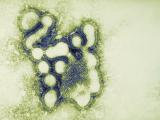Sep 14, 2012 (CIDRAP News) – The number of swine-origin H3N2 (variant H3N2, or H3N2v) influenza cases in the United States has climbed by 9 in the past week, to 305, and another rare swine-origin variant, H1N1v, has cropped up in Missouri, the Centers for Disease Control and Prevention (CDC) reported today.
The case in Missouri involves an H1N1v virus carrying the M (matrix) gene from the pandemic 2009 H1N1 (pH1N1) virus, marking only the second finding of such an isolate, the CDC reported. The previous case was reported in Wisconsin in December 2011; 12 other H1N1v cases (without the pH1N1 M gene) have been reported since 2005, CDC reports show.
The Missouri case was found because of increased surveillance for H3N2v cases, the CDC said in its weekly flu update. The patient got sick after contact with pigs and has since recovered. The agency gave no further details about the case.
The CDC's report on the H1N1v case in Wisconsin in December 2011 said similar viruses had been found in US swine since 2010 and that the strain was susceptible to antiviral drugs.
The CDC said the total number of variant flu cases detected since July has now reached 309. That includes the 305 H3N2v cases, the Missouri H1N1v case, and three H1N2v cases that were recently reported in Minnesota. All three strains contain the pH1N1 M gene.
Meanwhile, the Minnesota Department of Health reports that the number of H1N2v cases has increased to four, as one case previously listed as probable has been confirmed. The CDC says that when state and CDC case counts disagree, the state numbers should be considered more accurate.
The 305 H3N2v cases, most of which involved people exposed to pigs at county and state fairs, were scattered across 10 states. New cases were reported this week in Michigan, 1 (6 total); Minnesota, 2 (4); Ohio, 4 (106); and Wisconsin, 2 (20). Indiana continues to lead the list with 138 cases.
The numbers of H3N2v-related hospitalizations and deaths stayed the same, at 16 and 1, respectively.
The CDC said today, as it has previously, that a few cases of likely human-to-human transmission of H3N2v have been identified, but no ongoing human transmission.
Aside from the variant cases, flu remained at seasonably low levels in the United States last week, according to the CDC. The percentage of outpatient visits for flu-like illness stayed below the national baseline, and the percentage of deaths attributed to pneumonia and flu was under the epidemic threshold. No flu-related pediatric deaths were reported.
Globally, flu activity was low or decreasing in most regions, the World Health Organization (WHO) said in its biweekly flu update, covering the last 2 weeks of August.
Most countries in northern temperate regions have not started their seasonal flu reporting, but available data indicate that seasonal flu transmission has not begun in those areas, the WHO said.
Most tropical countries reported low or decreasing flu trends. The exceptions are Nicaragua, which is finding mostly influenza B, and India and Thailand, which are both reporting pH1N1 and B, the WHO said.
Flu activity declined in most temperate countries of the Southern Hemisphere, including Australia, Chile, New Zealand, Paraguay, and South Africa, the agency said. Argentina continues to report very low numbers of cases relative to previous seasons.
See also:
Sep 14 CDC flu update
CDC chart of variant flu virus cases since 2005
December 2011 CDC report on H1N1v case
Minnesota case count chart of H3N2v and H1N2v cases
Sep 14 WHO flu update
Sep 14 WHO flu virology update


















